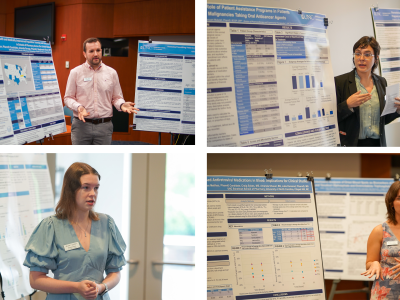April 6, 2010

Justin Richards, PhD, a postdoctoral fellow in the Division of Medicinal Chemistry and Natural Products, has received a Ruth L. Kirschstein National Research Service Award from the National Institutes of Health to support his project to better understand how the bacterial protein RecA contributes to the development and transmission of antibiotic resistance.
The grant is worth up to more than $143,000 over three years. Richards, who is in associate professor Scott Singleton’s lab, will use the funding for research aimed at determining the role that RecA’s myriad of activities play in the different ways bacteria try to survive an attack by antibiotics.
“The Kirschstein award is remarkably competitive with so many young PhD scientists with outstanding credentials applying,” Singleton says. “It’s a true honor for Justin to be recognized in this way, and his award distinguishes him as a young scientist who has all the skills and preparation to develop into a leader in medicinal chemistry.”
Recent research has shown that the most powerful antibiotics capable of killing bacteria do so by ultimately causing DNA damage within the bacterial cell through common pathways. When bacteria are under attack from antibiotics, RecA directs the SOS response in one of two ways. It can either help repair the damaged DNA, which preserves the genome and focuses on the survival of the individual cell; or induce mutation and recombination, which generate genetic diversity and allow the bacterial population to evolve in an effort to overcome antibacterial actions, thus leading to the development of resistance.
“The aim of my project is to try to tease apart the relative contributions of RecA’s activities to key biological processes involved in DNA repair and recombination,” Richards says.
Singleton says that because of the inherent complexity of these processes, traditional approaches to studying the topic have been unfruitful. Richards’s project will revolve around the development of a prototype RecA inhibitor discovered through a high-throughput screen of more than 33,000 small molecules by Tim Wigle, a former graduate student in Singleton’s lab. Results indicate that this compound selectively inhibits RecA’s recombinational activities while simultaneously permitting activities associated with early-stage SOS induction in bacterial cells to go on.
Richards will start off by synthesizing a pilot library of compounds built around the prototype inhibitor and run them through a series of assays to evaluate their biochemical and microbiological activities in the bacteria Esherichia coli,Neisseria gonorrhoeae, and Streptococcus pneumonia. He will then try to use the information obtained from the assays to design more selective and potent inhibitors.
“Another goal is to delineate structure-activity relationships to find what portions of the RecA inhibitors are eliciting the biological effect and tune them to get maximum potency,” Richards says. “It’s a feedback system loop, and when you get to the end of it, you take all the information you obtained and feed it back through the starting point. We have a number of robust assays that we can run that can tell us a lot of different information, which we can use to build better inhibitors.”
Richards says he is evaluating the compounds’ effectiveness in E. coli, N. gonorrhoeae, and S. pneumonia because in the latter two, RecA is not involved in any SOS response actions and only participates in recombinogenic processes related to the survival and adaptations to antibacterial activities.
“In N. gonorrhoeae and S. pneumonia, RecA only does one thing, whereas in many other bacteria, such as E. coli, RecA does two things,” he says. “By taking these small molcules which are selective for inhibiting RecA activities involved in DNA recombination in E. coli, we can then put them into bacteria where recombinational DNA repair is RecA’s only function with the belief that they will work also.”
In addition to shedding more light on the role that RecA plays in bacterial resistance to antibiotics, Richards says the work could have an overall profound impact on other research into bacterial infections, sexually transmitted diseases (through the study of N. gonorrhoeae), and global health (through the study of various disease states from S. pneumonia infections). Also, he says the project could contribute to drug development because RecA is a non-classical drug target and therefore inhibitors could be developed into potentiators of antibiotics to rearm them in the face of growing resistance.
“A lot of antibiotics and drugs in general have targets that, if you take that target out of the cell, the bacteria can’t survive,” Richards says. “But if bacteria don’t have RecA, they can still live; they just can’t repair their own DNA. It is well known that RecA mediates the abilities of a number of bacteria to overcome the metabolic stress induced by a range of antibacterial agents. Bacteria that lack RecA are highly sensitized to these drugs and the dose needed to kill the bacteria is smaller, which provides promise that RecA inhibitors could be used in the development of drug cocktails to treat infections.”
Richards joined the Division of Medicinal Chemistry and Natural Products in 2009 after earning a PhD in chemistry from North Carolina State University under Dr. Christian Melander. Before that, he spent two years as a medicinal chemist at Albany Molecular Research Inc. (Albany, NY) after receiving a BS in biochemistry from Clarkson University (Potsdam, NY).
Latest News

Dean Angela Kashuba receives Carolina Alumni Faculty Service Award

RASP poster presentations capture student research


